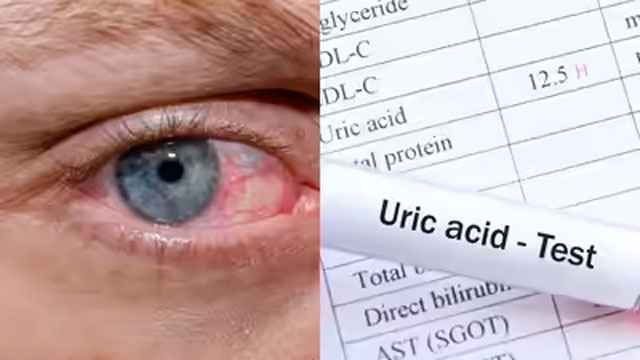Daijiworld Media Network - Mumbai
Mumbai, Oct 24: High uric acid levels, or hyperuricemia, are often associated with gout and kidney stones, but recent studies show that they can also affect eye health. Chronic hyperuricemia can cause inflammation, oxidative stress, and the buildup of monosodium urate crystals in various tissues, including the eyes. These deposits can lead to dry eyes, eye inflammation, and damage to the retina and optic nerve over time. Early detection and careful management of uric acid levels are crucial to prevent serious eye complications and maintain overall ocular and cardiovascular health.
Uric acid is a waste product formed when the body breaks down purines found in foods like red meat, seafood, and certain legumes. Normally excreted through urine, uric acid can accumulate when production exceeds excretion or kidney function is impaired. Excess uric acid may crystallize and deposit in ocular tissues, causing inflammation and tissue damage. Studies highlight that elevated uric acid levels can contribute to ocular complications, making monitoring essential for eye health.

Chronic hyperuricemia has been linked to dry eye disease, where tear production or quality is insufficient, causing irritation, redness, burning, and blurred vision. It can also lead to tophi formation, which are deposits of urate crystals in eyelids, conjunctiva, cornea, or orbital tissues. These can cause redness, swelling, and discomfort, and in severe cases, interfere with vision. High uric acid has also been associated with uveitis, inflammation of the uveal tract, which can result in eye pain, light sensitivity, blurred vision, and, if untreated, permanent vision damage. Glaucoma risk may increase due to oxidative stress and vascular dysfunction caused by elevated uric acid, potentially damaging the optic nerve. Persistent hyperuricemia can also affect the retina, causing microvascular changes and retinopathy, which may impair vision, especially in patients with cardiovascular or metabolic conditions.
Managing uric acid levels is key to protecting eye health. Medications can help lower uric acid and prevent crystal formation, while dietary changes, including limiting purine-rich foods and alcohol, support healthy levels. Adequate hydration helps flush uric acid from the body, and maintaining a healthy lifestyle through regular exercise and avoiding high-fructose beverages reduces systemic inflammation. Regular eye check-ups and careful control of uric acid are essential to prevent long-term complications and preserve vision.